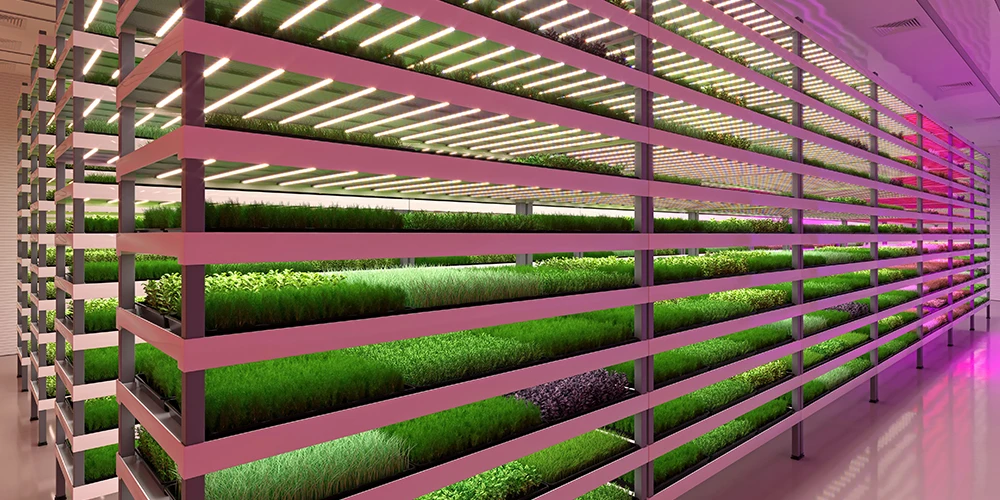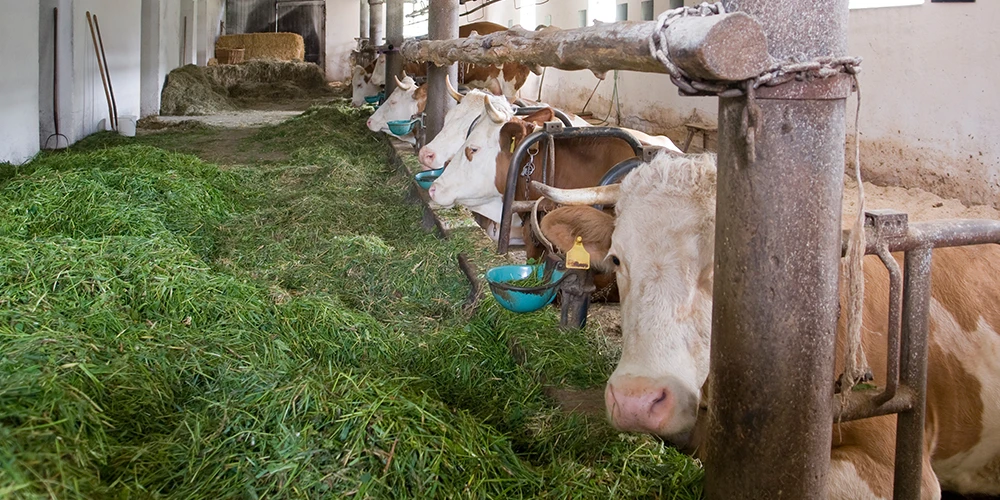Is Hydroponic Fodder Worth for Livestock Farming
Hydroponic farming is becoming popular because it’s efficient and sustainable. Hydroponic fodder, which has been around since the 1900s, allows farmers to grow fresh feed for their animals even in winter. Livestock like horses, chickens, and dairy cattle thrive on this fresh fodder, helping them gain weight and grow better, which can lead to higher profits for farmers.
Thanks to advancements in LED grow lights and hydroponic technology, these systems are now popular among both large and small farms. Hydroponic fodder now is nutrient-rich feed that grows quickly and offers many benefits. But is it really worth the investment for your livestock operation?
What is hydroponic fodder?
The idea of fodder dates back to ancient Egypt, where people started supplementing the grass animals ate with additional plants to improve their diet. Fodder is a type of feed made from plants like grasses, alfalfa, barley, and other grains, which are commonly fed to livestock.
In the winter, when fresh greens are hard to come by, growing your own fodder becomes a practical solution—especially when store-bought feed may not always be of the best quality. This is where hydroponic fodder comes into play.
Hydroponic fodder is a soil-free growing system that allows you to sprout grass from seeds using only water and careful environmental management. For some large hydroponic fodder farms, fodders are grown in multi-level racking systems with custom LED grow lights. It’s an efficient way to grow fresh, nutritious feed for animals year-round. Common seeds used in hydroponic fodder include barley (the most popular choice), alfalfa, oats, maize, lentils, and sunflower seeds.

How hydroponic fodder works
A hydroponic fodder system typically includes:
- Trays: A multi-level racking system that holds the growing trays, maximizing vertical space.
- Irrigation System: Delivers water precisely, ensuring optimal moisture levels for growth.
- Climate Control: Manages temperature and humidity to create an ideal growth environment.
- Lighting: Provides supplemental lighting to enhance photosynthesis and support healthy growth.
- Water Treatment: Adds nutrients and filters water to maintain quality.
Hydroponic fodder is grown directly in trays without soil, which reduces costs and simplifies indoor cultivation. From sprout to harvest, the process takes about 6–10 days, depending on specific conditions.
Steps to Grow Hydroponic Fodder:
- Seed Preparation: Clean and soak seeds in water for 12–24 hours. This softens the outer shell, promoting faster germination.
- Growing in Trays: Transfer seeds to trays and maintain a constant temperature (16–21°C) with artificial lighting to encourage growth.
- Harvest: Once matured, the fodder forms a dense mat of young plants with intertwined roots, resembling a strip of thick carpet. It can then be cut to appropriate sizes and fed fresh to livestock.
Benefits of hydroponic fodder
Hydroponic fodder offers a nutrient-rich, fresh, and live plant source that significantly enhances livestock health and productivity. Beyond providing a high-quality supplemental feed, this system brings numerous advantages.
Efficient use of water
The hydroponic system uses up to 98% less water compared to traditional soil-based farming. Additionally, recirculated water within the system can be consumed by animals, further optimizing water usage and minimizing waste.
Rapid growth time
Hydroponic fodder takes just 6 to 10 days from sprouting to becoming ready-to-feed fodder. This is a considerable reduction from traditional methods, which can take approximately 45 days, allowing for more frequent harvesting and a reliable food source.
More nutritious
In hydroponic systems, nutrients remain within the plant without leaching into the soil. Nearly all starch in the grain is converted to sugar, making it easier for animals to digest and fully benefit from the feed.
Enhancing animal health
Lush young green plants grown through hydroponic systems are highly palatable and digestible for livestock, supporting better animal health and enhancing the quality of their products, such as dairy, eggs, and meat. Research by CubicFarm Systems Corp has shown a positive impact on average animal weight and methane reduction. During the beef finishing stage, hydroponic fodder led to an approximately 9% increase in daily weight gain, a 6% boost in dry matter intake, and a 4% improvement in nutritional efficiency.
Marginal land usage
Did you know that conventional methods require around 25 acres to produce 1,000 kg of fodder? With hydroponic systems, only 480 square feet are needed, reducing land use by 99%. This allows farmers to make the most of marginal land while minimizing the need for long-term feed storage.
Ideal for limited land
In regions prone to drought or where land is scarce and expensive, hydroponic fodder systems offer a viable solution. They can be adapted to various space requirements, providing a consistent, year-round fodder supply in both large and small footprints.
Environmental friendly
Hydroponic fodder systems grow plants naturally, without the use of chemicals or pesticides, making them environmentally friendly. Additionally, water waste is minimal, promoting sustainable, eco-conscious cultivation.

Drawbacks of hydroponic fodder
Still need an outside seed source
While hydroponic fodder is a nutritious supplement, it cannot fully replace a livestock’s primary diet. Most companies recommend feeding hydroponic fodder at a rate of 2% of an animal's body weight, which only meets a fraction of their overall nutritional needs. Hydroponic fodder lacks sufficient roughage, which is essential for a balanced diet, meaning it serves as a supplement rather than a complete feed solution.
High costs
Hydroponic fodder systems require significant initial investment, and ongoing energy expenses for temperature and humidity control can be high, especially in extreme climates. Indoor systems may also incur additional costs for supplemental lighting, further impacting the overall cost-effectiveness of this feeding approach.
Require a lot of labor
Operating a hydroponic fodder system demands regular labor, including maintenance, seed purchasing, and system setup. While fresh feed can be provided during winter, handling wet sprouted fodder can be inconvenient and messy. Additionally, the time commitment can be substantial, particularly for larger farms, and does not necessarily yield more or higher-quality feed compared to traditional methods.
Strict cleaning and sterilization requirements
To prevent mold growth, which can reduce animal performance and even lead to health risks, rigorous cleaning and sterilization of trays and seeds are crucial. Commercial setups often use pre-sterilized seeds or clean trays with chlorine-based solutions. Without proper hygiene, mold risks increase significantly, potentially compromising feed quality and animal health.
Inconsistent performance results
The effectiveness of hydroponic fodder for animal health and production is still uncertain. Studies, including some from Italy in 2009 [1], have shown conflicting results on its impact on milk production and the well-being of sheep and goats. So far, many trials have not consistently proven that using green fodder as a grain substitute benefits livestock, highlighting the need for further research to confirm its effectiveness.
Is hydroponic fodder worth it for your livestock farm
Hydroponic fodder offers an appealing solution for livestock farms, providing fresh, nutritious feed year-round in a controlled environment. A well-managed system can transform seeds into lush, green plants in just 6 to 10 days while using significantly less water and land than traditional farming.
But is hydroponic fodder the right choice for your farm? Will it improve animal nutrition effectively?
Let’s explore the factors that determine its value.
First, the high initial costs for infrastructure, climate-controlled space, supplemental lighting, energy, and labor should be considered. Other essential factors include your current feed expenses and availability, local climate challenges, labor resources, energy costs in your area, and long-term farming goals.
For many farmers, particularly those in dry, drought-prone regions or facing high prices for conventional feed, hydroponic fodder can be a worthwhile investment.
[1] http://www.tandfonline.com/doi/abs/10.4081/ijas.2009.s2.625

